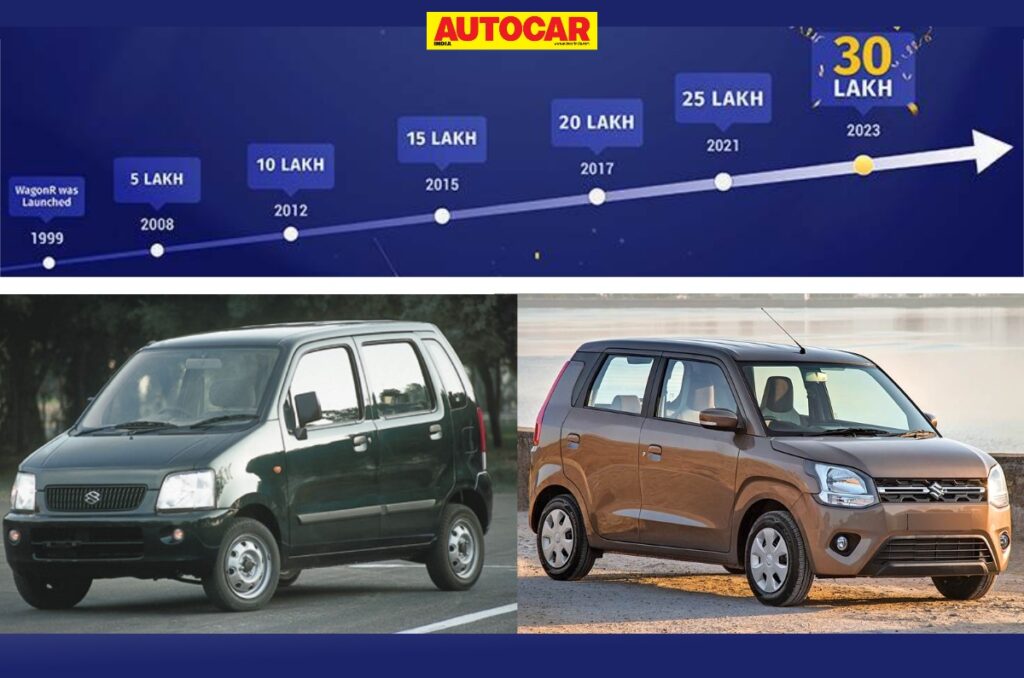
Maruti Suzuki says that over 32 lakh Wagon Rs have been sold in India since its launch in 1999.
Few cars have the same staying power as Maruti Suzuki’s Wagon R, which, this month, joins the elite club of nameplates that have been on sale in India for 25 years. The unique tall-boy hatchback arrived in India back in December 1999, and since then, Maruti says it has retailed over 32 lakh units, underscoring the Wagon R’s success story. Even in the last six months (June-November 2024), Wagon R wholesales have remained strong, averaging 14,612 units, and the hatchback regularly features in monthly top 10 sales lists despite the rising dominance of SUVs.
However, the now-popular hatchback did face some growing pains. When the first-generation model was launched in India to compete with the Hyundai Santro, the tall-boy design – which makes for a boxy exterior but uses vertical space to liberate more room on the inside – was not well received. Maruti Suzuki India’s senior executive officer for Marketing and Sales, Partho Banerjee, admitted, “Initially, when the Wagon R came, it was struggling. The tall-boy design was not at all accepted by the Indian consumer.” Historical data shows that it took the Wagon R nine years to reach the 5 lakh sales mark but just four more years to hit the 10 lakh milestone, which it achieved in 2012.
By the time this facelift launched in 2013, Maruti had already sold over 10 lakh Wagon Rs.
Over time, the practicality of the Wagon R shone through, especially its easy ingress and egress, which was particularly beneficial for the elderly and differently-abled. As the Santro, the Wagon R’s arch-rival with a similar body style, slowly exited the Indian market, the Wagon R stood out as the only ‘tall-boy’ in the market. This gave it a unique edge in a sea of conventional hatchbacks, helping it appeal to a wider audience. Speaking nostalgically about the Wagon R, Banerjee said, “I was a Wagon R customer back in 2000, and I was also the product head for it at the time. I still remember the ease of ingress and egress was amazing. Not even in today’s SUVs do you find yourself so comfortable [to get in and out].”
The Wagon R’s practicality is one of the key factors that has kept the sales counter ringing. Over three generations and numerous facelifts in the past 25 years, the Wagon R’s design hasn’t strayed from its boxy shape despite major styling overhauls. With the second-gen model came the Stingray variant, which certainly looked edgier than the standard version.
However, Banerjee says, “The soul remains intact. This was a vehicle that had substance and style, and the former was something that appealed to the people. Because style can keep changing, sometimes, maybe an edgier design will come, and other times, a more conventional one. But at the end of the day, the soul of the vehicle – the tall-boy design – is what has been appealing to the Indian customer.”
Besides its design and practicality, the Wagon R’s frugal nature over the generations has been a major draw. The first-gen model had a 67hp, 1.1-litre F10D petrol engine, and not long after, in 2006, Maruti introduced an LPG-powered version. Shortly after the second-gen Wagon R made its entry with a 68hp, 1.0-litre petrol engine, the company brought out a CNG-powered variant, which has been quite successful. This was another method Maruti employed to keep Wagon R sales high by appealing to different customer segments. “The important point is that, to different sets of consumers, the product was positioned in a very innovative way so that it appeals to them,” remarked Banerjee.
Now in its third generation, the Wagon R offers two petrol engine options and a factory-fit CNG option. It is this last version that currently accounts for a whopping 40 percent of Wagon R sales. Maruti says that one in every three cars the brand sells is CNG-powered and records sales of over 50,000 CNG vehicles a month. Banerjee says that the only real obstacle to greater adoption of CNG in India is the relative lack of fueling stations. “There are around 7,000 CNG pumps across India now, and the government plans to increase that number to 13,000 by 2030,” explained Banerjee. This bodes well for Maruti’s extensive CNG portfolio.
According to Banerjee, the typical Wagon R buyer is a family man (92 percent of consumers are male), with around 32 percent being business owners and about 20 percent self-employed. The spacious Wagon R’s utility as a people and goods mover only amplifies its desirability for its target audience. In addition, a massive 25 percent of Wagon R buyers are repurchasers, showing the incredible brand recall and loyalty this iconic tall-boy hatchback inspires.
While there’s no word on if or when the Wagon R-based EV will arrive in India – it has been spotted testing a number of times on our roads – and no information yet about a new-gen model or a facelift for the current model, it seems this unique hatchback is capable of continuing its hot streak in the market, perhaps for another 25 years.
Also see:
Maruti Suzuki Wagon R long term review, final report
Maruti e Vitara teased ahead of Auto Expo debut
Maruti achieves production milestone of two million vehicles a year


